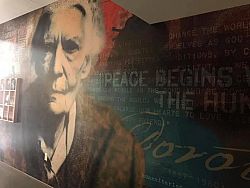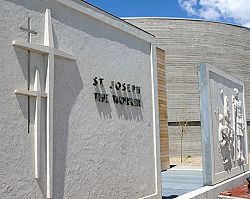The Year of Saint Joseph: The image of their patron saint as the exemplar laborer stands at the heart of Saint Joseph the Worker Parish in West Jordan

Michael Courtney
Diocese of Salt Lake City Archivist
“Dear workers, our meeting is illumined by the figure of Joseph of Nazareth and by his spiritual and moral stature, as lofty as it is humble and discreet. The promise of the Psalm is fulfilled in him: ‘Blessed is everyone who fears the Lord, who walks in his ways, You shall eat the fruit of the labour of your hands; you shall be happy and it shall be well with … Thus shall the man be blessed who fears the Lord’ (127: 1-2, 4). The Guardian of the Redeemer taught Jesus the carpenter’s trade, but above all he set him the most valuable example of what Scripture calls the ‘fear of God,’ the very beginning of wisdom, which consists in religious submission to him in the deep desire to seek and always carry out his will. This, dear friends, is the true source of blessing for every person, for every family, and for every nation.”
St. Pope John Paul II spoke the above words in his Jubilee of Workers Homily on May 1, 2000, the feast day of St. Joseph the Worker, to remind believers that “in God’s plan, work is therefore seen as a right and duty. Necessary to make the earth’s resources benefit the life of each person and of society, it helps to direct human activity towards God in the fulfillment of his command to ‘subdue the earth.’”
Following God’s plan, Joseph of Nazareth taught his adopted son Jesus about the importance of work and how to use labor and the resources God provided them through their labor to benefit not only their family but also the people in their community. The model of St. Joseph the Worker illustrated by John Paul II’s homily is one that the people of West Jordan have followed since moving into the area from Bingham Canyon in the early 1960s. The model has changed over time, but the core principles of the value of labor and employing labor and resources for the benefit of self, family and society remain the same.
The founding pastor of St. Joseph the Worker Parish, Father John Sullivan (later monsignor) fought hard for workers’ rights and their dignity. In April 1956, Fr. Sullivan wrote the Most Rev. G. Duane Hunt, fifth Bishop of Salt Lake City, to inform him that Kennecott Copper Mining discriminated against Mexican workers. After reading the priest’s letter, Bishop Hunt inquired about Fr. Sullivan’s claims with Kennecott Mining Company’s President Parnell Caulfield. Bishop Hunt told Parnell, “inasmuch as many of the Mexicans are Catholics, I am a little bit disturbed about this.” Caulfield reassured Bishop Hunt that Fr. Sullivan misunderstood the conversation with Kennecott’s representative and that the company didn’t discriminate against anyone because of national origin. Fr. Sullivan told the bishop that he hadn’t misunderstand the discussion with Kennecott and that he “would be willing to take an oath as to the truth of this statement.” In the end, Caulfield’s answers satisfied Bishop Hunt.
Fr. Sullivan used the tools and talents God gave him to stand up for the well-being of workers. The early parishioners of St. Joseph the Worker utilized the means God sent them to build the first St. Joseph the Worker Catholic Church. In 1964, the miners of Kennecott Copper Company went on strike. During this time, construction was to begin on St. Joseph the Worker Mission. The strikers decided, while they were on walk out, they would donate their time to build the church, even though Fr. Sullivan wanted to pay them. Because these volunteers did not work in construction, erecting the church came with some daunting challenges. The miners overcame these issues with aplomb. According to Something Beautiful for God: New Worship and Welcome Center for St. Joseph the Worker Catholic Church, “to form the supporting arches they constructed them on the ground in two parts then raised them with a crane and fastened them together. To do this, they chose the smallest worker, a 19-year-old, who rode on the crane. This is a unique example of how they developed and applied construction methods.”
Another problem arose before the dedication of the church. The church needed Stations of the Cross and a crucifix crafted in Italy, which wouldn’t arrive in time for the first Mass. The men found a solution to these problems. First, they took a crucifix from their mother church, Immaculate Conception Church in Copperton, and brought it by truck, on their laps, to St. Joseph the Worker. Then they hung purple cloth for the Stations of the Cross.
On May 16, 1965, the Most Rev. Joseph L. Federal, sixth Bishop of Salt Lake City, dedicated St. Joseph the Worker Mission. For the workers, it “provided a deep sense of belonging and community. … The completed church was a tangible sign of their faith and holy community” (Something Beautiful for God).
Commitment to labor and its value for the parish community continues today. On May 1, 2012, to celebrate the parish’s one-year anniversary of the blessing of the new church structure, the parish held a workers’ prayer service honoring their patron saint. The theme centered on the dignity of the worker. The workers’ prayer service included the unveiling of a mural of Dorothy Day and a presentation by Judy Barnett, Utah AFL-CIO communication director. The parish also named their food pantry in honor of Dorothy Day. Fr. Patrick Carley, pastor, explained that Day “stood for the causes of the poor, the homeless and the disenfranchised.”
At the service, Barnett expressed her gratitude toward labor unions: because of labor unions, there is an eight-hour workday, overtime pay, safe work environment and non-discrimination statutes. Moreover, personally for Barnett, the local AFL-CIO chapter backed her while she worked and raised her family as a single mother.
The foundations of St. Joseph the Worker Parish are firmly rooted in Catholic social teaching on labor with the image of St. Joseph as an ideal worker. Just as St. Joseph did more than 2,000 years ago, the parish community has been using their labor to better their church, community, and the world, understanding that the ultimate teleology of labor is to bring people to God.
© Copyright 2024 The Diocese of Salt Lake City. All rights reserved.


Stay Connected With Us